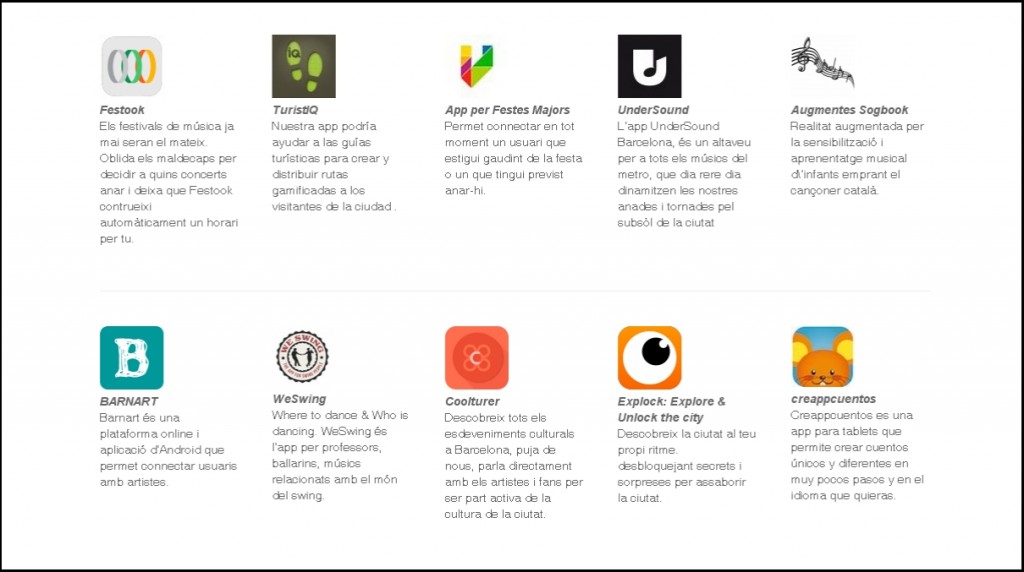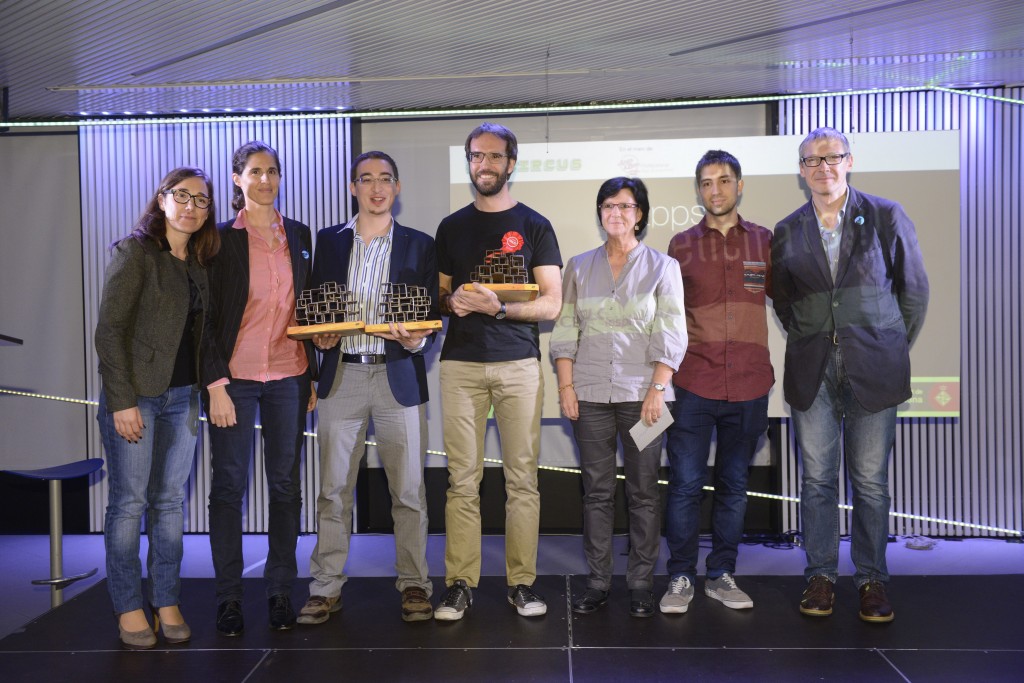Conxa Rodà
10 apps have been the finalists of the #Apps Cultura 2014 awards out of 28 projects which involved 415 participants in this second Edition. Our museum was invited to form part of the jury that last Friday decided on the winners in a final gala which took place in the headquarters of the Barcelona Mobile World Capital.
The winning apps were:
■ First overall prize and most voted by the public: Barnart, a platform that allows the public to be connected to the artists, it geolocalises them, and includes an option to make donations via Pay-Pal.
■ Most innovative concept: Festook, a smart system for recommending festival programming (in the prototype, only music, with the aim of growing to other types of festivals, such as cinema, dance, etc.).
■ To be incorporated in the phase of acceleration: Coolturer, a cultural agenda of Barcelona, that can be highly personalised and that acts as a platform for promotion and as a social network between the public and artists.
Other apps with interesting proposals were:
UnderSound, to geolocate and listen to the musicians of the underground of Barcelona
Augmented Songbook: that incorporates augmented reality for the children musical learning
TuristIQ, to create and distribute gamification routes around the city
The #AppsCultura awards are an initiative from the Department of Creativity and Innovation of the Institute of Culture of Barcelona, together with AppCircus. I’d like to mention here the winner of the first edition last year, Unique Visitors, awarded as the best innovative concept and the most voted app by the public. It offers a system of personalised itineraries to museums, cerated by visitors. The works of the collection of the Museu Nacional and of the Fundació Miró were used to produce the pilot project. Currently, Unique Visitors, based on our new presentation of the modern art collection, invites the users to create 52 different visits to the Museu Nacional.
Some common features of the new apps
■ imagination to detect niches of interest or needs not covered of the users
■ to provide multiple ways of user participation
■ to include personalised and relevant information for the public, which means that the more an app is used, the more accurate the recommendations it makes.
■ simplification of the browsing, clearer designs
3 topics to reflect on and debate
This event, created to boost culture from the mobile, is an excellent example that, with a suitable stimulus, innovation can flourish. Nevertheless, of the presentations made and from the session of Q&A, plus my experience with developers and technological companies, to me it highlights the fact that there is still a long and common way to go in various aspects. This is a very logical fact, though, in an environment of accelerated growth and of constant change, that requires an additional dose of effort, innovation and collaborative work.
■ Technology before the design and the usability?
In one of the presentations, well-conceived but with poor visualisation, something was said that is heard quite frequently: “we have focused firstly on the technological development, which is the most complex, and then the design will come”. I believe that you can’t consider the visual presentation and the navigation as an “after-thought”, nor it is something trivial. This should precisely be present from the start of any digital project. The design of an app, like that of a website, goes much further than just achieving an aesthetic effect, it goes straight to the waterline of the experience of the user, it makes the proposal more attractive, more usable, accessible, easy to browse, and consistent, and it places the audience at the focus of the proposal.
■ Little attention to the elaboration of content for digital projects.
It is relatively frequent that people talk about platforms or developments that allow you to do wonders, and take for granted that the content will be there. But, watch out, because elaborating good compelling content, suitable for each platform, is the hard core of digital projects. The platform can let you create interactive routes, but the difficulty arises for the museum to create relevant content, contextual, multimedia and entertaining. The platform can incorporate games. Excellent. But to elaborate games, and more so now with the explosion of gamification, requires art and science. Among the developers, who master the technological tools, and the museums, that have the content, we often lack another leg for the production of digital content. Often, either due to enthusiasm or lack of resources, we jump in head first, and it is very good to do so, but then productions may not reach the levels of excellence we wish. With remarkable exceptions, of course, both in local and international museums.
■ We still see museum apps (and from other fields) that don’t get the most out of the genuine functionalities of mobile: the geolocalisation, the “here and now” recommendations, the augmented reality, sharing, providing contextual information. We should provide our apps with everything that can’t be done/seen in the physical world or from a desktop computer. This is the app intrinsic value, which enriches the experience, and really makes sense.
We are in an extremely interesting moment in terms of the transformation in the creation and distribution of content. The digital revolution is full of possibilities if we get the most out of them. The landscape becomes more and more complicated, now, among others, with wearable technology and transmedia storytelling.That’s why to me it seems essential the collaborative work between the technology and museum sectors from the outset of the projects. Joining forces right from the start, we will achieve better digital projects and, above all, we will improve the experience of our users.
Do you feel the apps enrich the experience of the visit to the museum or do you consider them a disruptive element? Which cultural app of those you have used would you like to highlight? Please, leave a comment!Related links
Making visitor information easier for mobile phone users
Co-directora del Curs d'Estratègia Digital_UOC_Museu Nacional d'Art de Catalunya
Co-directora del congrés CIMED de Museos y Estrategias Digitales










